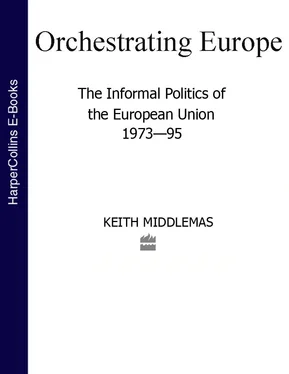Previously, these had been heavily protected areas: in Germany, insurance protection law meant that all policies were similar, with strict tariffs, so that innovation was impossible. This was in complete contrast to the competitive market in Britain, which regulated intermediaries, not policies. In France it remained a criminal offence for non-French companies to sell any sort of insurance. Some liberalizing had been achieved by the EC on life and non-life policies, but full market freedom was not actually achieved until 1990, after nearly twenty separate Commission drafts. Until then, the governments of Germany, France, Belgium, Italy, Denmark and Luxembourg resisted any change, to the unconcealed fury of German companies and all multinationals. It was no wonder that Cockfield avoided legislating for this sector, relying, as 1992 approached, on the single market’s momentum to do the job. 59
Talk about ‘Europe à la carte’ and ‘variable geometry’ during the Presidencies of the Netherlands, Britain, Belgium and Denmark in the years 1986–8 revealed how fortunate the EC had been in the previous year under Italy and Luxembourg. Britain was evidently keen to prevent the emergence of a contingent social policy dimension. As the Thatcher decade neared its end, and as she herself attempted to limit any broadening of the single market concept, Britain seemed once more to be at loggerheads with the rest. Among member states, it seemed as if the impetus had been lost.
The breakthrough under Germany’s Presidency at Hannover can be explained partly because of France’s occlusion, during the tense period of ‘cohabitation’ between Mitterrand (who during a long duel between Elysée and Matignon managed to retain power over foreign and EC affairs) and Jacques Chirac’s RPR government, and partly by a convergence of opinion between Bonn and German industry on the substantial opportunities for Germany offered by the internal market. The Hannover Summit also indicated that West Germany had committed itself to political, if not yet monetary, union.
Even then, some elements remained uncertain, such as harmonizing VAT, which was fought out between Cockfield (who sought a 17% rate) and the responsible Commissioner, Christiane Scrivener (who proposed a 12% one), at ECOFIN meetings under the Greek Presidency in late 1988. The British government again objected to the principle of harmonization, but in the long run, when Norman Lamont was at the Treasury in July 1992, accepted it as an irreversible matter – one essential for raising government revenue during the 1990s’ recession.
The years 1988–90 were good ones in the EC, which saw a rise in corporate profits, individuals’ living standards, and their expectations (at least for those in work, and above all in skilled or professional work), as the boom swept towards its crescendo. European directors of Ford, IBM or Exxon had long seen what Cockfield’s timetable presaged, as did some Japanese multinationals, and were now eager to set up inside the EC before the 1992 deadline. More and more giant firms such as Rhône-Poulenc (chemicals) and Philips (electronics), and Daimler-Benz (cars), opened offices in Brussels, where lobbyists multiplied, pari passu with the Commission’s output of SEM directives, giving greater complexity to the game. Many of the deals or joint ventures made in this period (British Leyland-Honda, Fiat-Sikorsky and Westland Helicopters, together with Siemens-GTE (USA), CGE-AT&T, and Telefonica-Fujitsu (in telecoms)) suggest that multinationals were actually demonstrating what a single market implied and perhaps defining what EC industrial policy and trade policy in the future should be.
But the most obvious result of Hannover was a renewed mood of optimism, and a determination to consolidate the entire project of monetary and political union. Cecchini had dealt largely with once-for-all benefits deriving from the original White Paper. But by 1989–90 it seemed that, if the single market did help to solve the underlying problems of the EC’s overall adjustment, the gains to be expected after 1993 would be vastly greater – at least for the northern European states – than he had predicted, not least because adjustment could provide means to counter US, Japanese and south-east Asian firms’ market penetration.
In that sense the achievement of an internal market, though the direct consequence of the Single European Act, cannot be isolated from the wider process which culminated at Maastricht in December 1991. For a relatively short period, member states accepted what had already become common sense in the business and financial communities, that the internal market’s likely gains offered greater advantage than earlier economic defensiveness. There could be no value in being the last to come in or the least conciliatory, since the game had ceased to be a zero sum matter; such defensive stances risked being overruled or gaining nothing, whereas the propensity to bargain represented an attractive alternative.
Yet member states’ ratification of the Single European Act hid a number of individual government reservations and, in the British case, perhaps also misconceptions about what had been accepted by the others and the Commission as logical corollaries. Hannover marked a point of political assent to the concept of a rule-based system in which sectional opting-out or evasion would become unprofitable, just as the pledge on EMU provided the necessary technical accompaniment (apart from Britain and Denmark) to avoid unmanageable distortions in the new market and the CAP. That in turn brought huge pressure on Britain and Spain to enter the ERM if they wished financial liberalization to reach its apogee.
The way the internal market was made cannot be isolated from the international context and the Gorbachev era of apparently ultimate détente, followed by the collapse of the Soviet empire in 1989–90, which opened up the countries of eastern Europe to new forms of exchange with the EC. West Germany’s leadership at Hannover prefigured its likely stance two years later as the Wall, and its accompanying psychological walls, came down.
Peter Sutherland, the Commissioner responsible for competition policy, had been appointed to lead the high-level Group on Operation of the internal market, in order to assess how best to achieve the full benefits Cecchini had promised. In his report, analysing post-1992 problems in managing the internal market, he pointed out that the Community’s main functions would now be to administer the rules, monitor member states’ compliance, improve their means of doing so, spread an understanding of the law to ensure consistency and transparency, and generally help to create a climate of shared responsibility in which the Commission would henceforward rely on member states’ competence and expertise, and on their courts for enforcement. The Single European Market was to become the core of a new EC geography which would in turn redefine the relative positions of Commission, member states and ultimately regions. But even in his chosen areas of goods and services, a great deal remained to do.
If this represented a new stage of partnership between them, it was clear from what Sutherland said that the Commission would have to accept some informal degree of diversity in practice among the Twelve, whatever its formal legal standpoint. The advance on the previous decade was nevertheless enormous, whether the Single European Act is depicted as the result of a tacit contract between all twelve member states or of a number of parallel decisions by each government about relative advantage. Either way, each player would respond to the rules, not because of the sanctions (which were negligible and had often enough been evaded in the past) but because of the severe and increasing costs of not doing so. Nevertheless, a number of substantive contingent questions remained to be settled, including the emphasis to be given to competition policy, and the Commission’s place in developing industrial and external trade policies, research and technology programmes. The Act nowhere stated that Article 115, which gave powers to take protective measures against non-European imports, would be removed; neither did it lay down details about progress towards monetary union – if it had, its passage would have been immeasurably harder.
Читать дальше









![Brian Thompson - A Monkey Among Crocodiles - The Life, Loves and Lawsuits of Mrs Georgina Weldon – a disastrous Victorian [Text only]](/books/704922/brian-thompson-a-monkey-among-crocodiles-the-life-thumb.webp)


